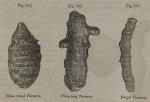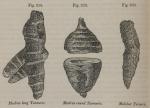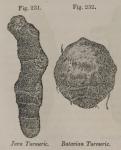 Sex. Syst. Monandria, Monogynia.
Sex. Syst. Monandria, Monogynia.
(Rhizoma, L. E.—Radix, D.)
History.—Turmeric is probably the κύπειρος ινδικός (Cyperus indicus) of Dioscorides. [Lib. i. cap. iv.] Both he and Pliny [Hist. Nat, lib. xxi. cap. lxx. ed. Valp.] state that this Indian Cyperus has the form of ginger, and that, when chewed, it colours the saliva yellow like saffron. The word curcuma is derived from kurkum, the Persian name for saffron. [Royle, Essay on the Antiquity of Hindoo Medicine, p. 87.]
Botany. Gen. Char.—Tube of the corolla gradually enlarged upwards; limb 2-lipped, each 3-parted. Filament broad. Anther incumbent, with 2 spurs at the base. Style capillary. Capsule 3-celled. Seeds numerous, arillate.—Stemless plants, with palmate tuberous roots. Leaves with sheathing petioles, bifarious, herbaceous. Scape simple, lateral or central. Spike simple, erect, comose, somewhat imbricated at the base with bracts or saccate spathes. Flowers dull yellow, 3 to 5 together, surrounded by bracteolas. [Blume, op. cit.]
Sp. Char.—Bulbs small, and with the numerous, long, palmate tubers, inwardly of a deep, orange yellow. Leaves long-petioled, broad-lanceolate, of a uniform green (Roxburgh).
Hab.—Much cultivated about Calcutta, and in all parts of Bengal, also in China and Cochin-China. One acre yields about 2000 lbs. of the fresh root.
Description.—The tubers, called in the shops turmeric (radix curcuma), seu terra merita), are of two kinds: one round (curcuma rotunda), the other long (curcuma longa), but both produced on the same plant. The first are round, oval, or ovate, about two inches long, and one inch in diameter, pointed at one end, and marked externally with numerous annular wrinkles. The second are cylindrical, not exceeding the thickness of the little finger; two or three inches long, somewhat contorted, tuberculated. Both kinds are yellowish externally, internally more or less orange-yellow passing into reddish-brown. The fractured surface has a waxy appearance. The odour is aromatic, somewhat analogous to ginger, but peculiar; the taste is aromatic. When chewed, it tinges the saliva yellow. Its powder is orange-yellow. The tubers are frequently worm-eaten.
If a thin slice of turmeric root be examined by the compound microscope, it is seen to consist chiefly of rounded or oblong, yellow, readily separable cells or vesicles, which appear to be filled with a minutely granular matter, and to be contained in an hexagonal cellular tissue. Intermixed with these cells are observed globules of a viscid, oleaginous, orange-coloured liquid. By boiling the slices in rectified spirit, the oleaginous liquid is dissolved, and the cells are deprived of their yellow colour. The colourless cells appear still to be filled with a granular matter. On the addition of iodine, the cells, but not the hexagonal tissue in which they are contained, acquire a dark blue colour, showing their amylaceous nature.
Varieties.—Five varieties of turmeric are known in the English market, namely, China, Bengal, Madras, Malabar or Bombay, and Java turmeric. These are readily distinguishable from each other by their external appearance; but if they were sorted according to their resemblance, the China and Java turmerics would be placed in one group, the Madras and Malabar in a second group, and the Bengal in a third.
1. China Turmeric.—This sort consists of smooth, plump, round, and long tubers (curcuma rotunda et longa, Figs. 225 and 226) of a greenish-yellow hue externally. They yield a bright powder, and on that account are much preferred for medicinal purposes. Hence they fetch a higher price than any other sorts of turmeric. Probably if much of it were brought to market, it would not fetch more than the Bengal sort.
2. Bengal Turmeric.—This sort consists of thin or narrow long tubers (curcuma longa, Fig. 227) which are moderately smooth externally, and of a grayish dull yellow colour. They break with a deep reddish fracture. Although, from the dull appearance of its narrow tubers, it is not a very inviting sort to the inexperienced eye, yet it fetches a higher price than the Madras sort, on account of its being a much stronger dye.
 3. Madras Turmeric.—This is the most showy of all the kinds of turmeric. It consists principally of large long tubers (curcuma longa, Fig. 228), but mixed with transverse segments of round tubers (c. rotunda, Fig. 229). Externally, the tubers are marked by longitudinal wrinkles, the surface of which is rubbed and bright yellow; internally, the colour is that of a fresh-fractured surface of gamboge.
3. Madras Turmeric.—This is the most showy of all the kinds of turmeric. It consists principally of large long tubers (curcuma longa, Fig. 228), but mixed with transverse segments of round tubers (c. rotunda, Fig. 229). Externally, the tubers are marked by longitudinal wrinkles, the surface of which is rubbed and bright yellow; internally, the colour is that of a fresh-fractured surface of gamboge.
4. Malabar Turmeric; Bombay Turmeric.—This sort is not constantly found in the market. It consists principally of long tubers (c. longa, Fig. 230); the round tubers (c. rotunda) being few and of very inferior quality. This sort of turmeric is smaller and more shrivelled than the Madras sort, but otherwise somewhat resembles it.
 5. Java Turmeric.—Not frequently found in the English market. In a general way, it may be said to resemble the China sort. It consists of both round and long tubers (c. rotunda et longa, Fig. 231), but chiefly the latter. They have a greenish-yellow hue.
5. Java Turmeric.—Not frequently found in the English market. In a general way, it may be said to resemble the China sort. It consists of both round and long tubers (c. rotunda et longa, Fig. 231), but chiefly the latter. They have a greenish-yellow hue.
Under the name of bulbs of Batavian turmeric, I have received a sample of round tubers (Fig. 232) said to be from Java. Dr. Th. Martius notices this sort as having been brought for many years from Batavia, and adds that it contains much colouring matter, and is probably the produce of Curcuma viridiflora.
Composition.—Two analyses of turmeric have been made; one by John, [Gmelin's Handb. d. Chem.] and a second by MM. Vogel and Pelletier. [Journ. de Pharm. i. 289.]
| John's Analysis. | Vogel and Pelletier's Analysis. | |
| Yellow volatile oil. | 1 | Acrid volatile oil. |
| Curcumin | 10 to 11 | Curcumin. |
| Yellow extractive | 11 to 12 | Brown colouring matter. |
| Gum | 14 | Gum (a little). |
| Woody fibre | 57 | Starch. |
| Water and loss | 7 to 5 | Woody fibre. |
| ---- | Chloride of Calcium. | |
| Turmeric | 100 | ---- |
| Turmeric. | ||
Curcumin. Yellow Colouring Matter.—Is obtained, mixed with some volatile oil and chloride of calcium, by digesting the alcoholic extract of turmeric in ether, and evaporating the ethereal tincture to dryness. In the mass, curcumin is brownish-yellow, but when powdered it becomes full yellow. It is tasteless, odourless, almost insoluble in water, but readily soluble in alcohol and ether. These properties show that it is of a resinous nature. The alkalies colour it reddish-brown, and readily dissolve it. The alcoholic solution, evaporated with boracic acid, becomes red. Hydrochloric acid, also, reddens it. The alcoholic solution of curcumin produces coloured precipitates with several salts, as acetate of lead and nitrate of silver.
Chemical Characteristics.—The alkalies change an infusion of turmeric, or turmeric paper, to reddish-brown. A similar alteration of colour occurs when turmeric paper is exposed to the vapour of hydrochloric acid gas, or is touched with oil of vitriol. If, to tincture of turmeric, boracic acid be added, and the mixture be evaporated to dryness, an orange-red residue is obtained, whereas, without the acid, the residue is yellow. By this test the yellow colouring matter of turmeric can be distinguished from that of rhubarb (see Rheum). Sulphate of copper causes a yellowish precipitate with an infusion of turmeric. A similar effect is produced by sesquichloride of iron.
Physiological Effects.—Are those of a mild aromatic stimulant (see vol. i. p. 253). The colouring matter becomes absorbed, and communicates a yellow tinge to the urine. [Lewis, Mat. Med.; and Reiger, quoted by Murray, App. Med. vol. v. p. 78.] According to Mr. Gibson, [Mem of the Lit. and Phil. Soc. of Manchester, vol. i. 2d ser. p. 148.] the colouring matter of turmeric is somewhat changed by the digestive organs; for the stools of animals fed with this root were green, whilst both logwood and madder exhibited their respective hues after passing through the intestines.
Uses.—Employed as a condiment, colouring ingredient, and test. It is a constituent of the well-known curry powder and curry paste, and of many other articles of Indian cookery. Formerly, it had some reputation in hepatic and other visceral diseases, and especially in jaundice.
As a test, it is used to detect the presence of free alkalies, which change its yellow colour to a reddish-brown.
But alkaline earths and the alkaline carbonates, borates, and sulphurets, as well as boracic and hydrochloric acids, change the colour of turmeric from yellow to brown. Though not a very delicate test, it is often a very useful one.
1. TINCTURA CURCUMAE; Tincture of Turmeric—Prepared by digesting one part of bruised Turmeric in six parts of Proof Spirit. Employed for the preparation of turmeric paper. Diluted with water, it yields a slightly turbid yellow liquid, which is sometimes used in the class-room as a test for alkalies, &c.
2. CHARTA CURCUMAE; Charta exploratoria flava; Turmeric Paper.—Prepared with white, bibulous, or unsized paper, which is to be brushed over with, or soaked in, tincture of turmeric, and dried in the air, the access of alkaline and acid fumes being prevented. Mr. Faraday [Chemical Manipulation.] directs it to be prepared with a decoction of turmeric (prepared by boiling one ounce of the coarsely-powdered turmeric in ten or twelve ounces of water, straining through a cloth, and allowing the fluid to settle for a minute or two). Turmeric paper is employed as a test for alkalies, &c, which render it reddish or brownish.

